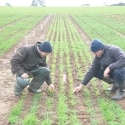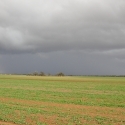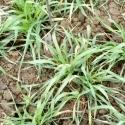22 Jul 2014
Aluminium toxicity seen - liming next season
Reported from Joel-Joel in the eastern Wimmera
 Aluminium toxicity in wheat
Aluminium toxicity in wheat
An interesting case came through from local agronomist Ben Cordes of Tylers Hardware and Rural Supplies in Rupanyup. The wheat sown in the third week of May is showing poor growth - both tops and roots. The paddock had two parts to it - a heavier clay loam flat and a lighter loam rise. The crop was quite well supplied with nutrients at seeding, but the poor performance is put down to acidity and in particular aluminium toxicity.
Aluminium toxicity shows up often as purpling of the older leaves and tillering is poor. The older leaves may look withered, even though water supply is adequate. Plants are stunted and may die leaving bare patches in the field.
The roots are also affected, and they become stunted and have a characteristic brownish could with the root tips "burned" off. Because of these root effects, tissue tests may show lower nutrient content, but it is a problem of access, not necessarily supply. As well, nutrients like P are less available when soil pH falls below 5.
A soil test - as below - taken at sowing showed the heavier and lighter parts of the paddock had similar (and probably adequate) N status and Colwell P and exchangeable K levels are OK. So, overall basic nutrient status looks satisfactory.
Light Soil 0-10 cm | Light Soil 10-20 cm | Heavy soil 0-10 cm | Heavy soil 10-20 cm | |
| Texture | Clay Loam | Sandy Loam | Clay | Clay |
| pH (CaCl2) | 4.20 | 4.30 | 4.60 | 5.70 |
| ES (Sat. Extr.) | 1.40 | 0.50 | 1.50 | 0.70 |
| CEC (cmol/kg) | 2.65 | 1.49 | 8.01 | 10.30 |
| Ex-Na % | 3.8 | 3.0 | 9.2 | - |
| Al Sat % | 14 | 23 | 2.7 | - |
| Al (mg/kg) | 32 | 31 | 20 | - |
| Nitrate (mg/kg) | 6.0 | 1.9 | 5.6 | 2.4 |
| Ammonium (mg/kg) | 7.4 | 2.1 | 6.8 | 2.4 |
| Colwell P | 26 | 15 | 43 | 9 |
| ex-K (cmol/kg) | 0.42 | 0.18 | 0.45 | 0.38 |
Soil pH and exchangeable aluminium levels show the problem. On the lighter soil, acidity is below 4.5 (calcium chloride), and at this sort of pH, aluminium becomes more available and so become toxic to a range of crop and pasture species. If the pH is less than 4.8 and the exchangeable Al% is more than 5%, pastures and susceptible crops such as canola, albus lupins and many wheat and barley cultivars will show symptoms.
The soil test shows exchangeable Al to be 14% in the topsoil and rising to 23% in the subsoil. At these levels, even quite tolerant species such as oats and triticale will be affected. The NSW DPI leaflet (see bottom to download) gives a very good description of the issue and the strategies to adopt.
Clearly, the soil needs to be limed, and this will have to wait until prior the next crop for this to occur. The whole paddock does not need to be limed, as the heavier parts have only moderate acidity, with low exchangeable Al, so the response to liming would not be as high as the lighter parts of the paddock. If liming was not to be done, then only acid tolerant species and varieties for the next crop would need to be selected.
IPNI has produced a guide to liming and this can be accessed and purchased using the link at left.
Thanks to Ben Cordes for supplying the photos below.
Additional Resources
NSW DPI Liming LeafletSize: 0.11 MB










